Vice Chairman of Keidanren
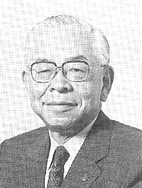
Tadahiro Sekimoto
Vice Chairman of Keidanren

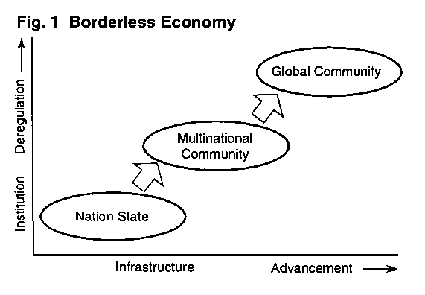
As you can see from Figure. 1, the world is moving from a collection of nation-states toward a multinational community, with the support of the deregulation of institutions and advancements in infrastructure. I believe that a true "global community" will become a reality within the 21st century.
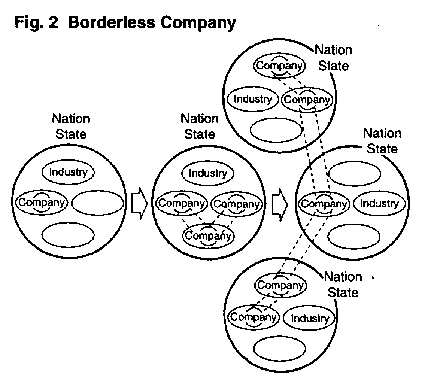
The second figure illustrates the trend for corporations to diversify into new areas of domestic operation. Nippon Steel, for instance, is no longer just a steel manufacturer -- it has been involved in fields as diverse as biotechnology and telecommunications since 1987.
Along with domestic diversification, corporations are expanding worldwide and establishing borderless operations as shown in this figure.
Such expansion is no longer confined to joint ventures with U.S. or EU corporations. The overseas production ratio for Japan is currently 6.2 percent, compared to figures such as 20 percent to 30 percent for the United States.
My firm, NEC, for example has 100 bases in 45 countries, including 33 manufacturing subsidiaries in 15 countries; 44 sales and service subsidiaries, and 24 representative offices in 22 countries. What I am saying here, is that in a borderless economy that encourages this kind of borderless corporation, we are now at the stage where we have to start thinking seriously about global trade.
Let me deal briefly with Japan's trade relations with other countries. In regard to our relations with Europe, Japan last year celebrated the 450th anniversary of its historical relationship with Portugal, which began in 1541. In contrast, Japan's relationship with the United States is barely 140 years old, having begun with the arrival of Commodore Perry in 1853. Our relationships with most other Asian nations were launched at the beginning of the 20th century, although our links with China go back nearly 2,000 years.
Thus, you can see that Japan has a unique relationship with each country. There are several difficult issues that need to be resolved in our relations with Europe and Asia -- but none of these is insurmountable. In contrast, our relationship with the United States has been characterized by continual trade friction in spite of our mutual recognition of each other's importance as trading partners.
Our current trade ratio with the United States is 29.2 percent for exports and 23.0 percent for imports, while the U.S. ratio with Japan is 10.3 percent for exports and 18.5 percent for imports. These figures underscore the extent of our interdependence and importance to one another as trading partners.
Next year is the 50th anniversary of the end of World War II. Through the postwar period Japan viewed the United States as an elder brother, even a father-figure. Even today, Japan has not forgotten the kindness bestowed by the United States as the elder brother in helping the Japanese people rebuild their nation. We believe that we have grown to be a good younger brother. As I have repeatedly pointed out, it is essential to the future of not only our nations, but of the entire world, that we strive to maintain this close "brotherly" relationship in the future.
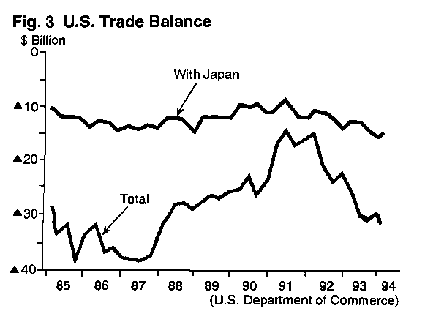
Unfortunately, we are faced with the reality of continuing trade friction, a problem that is painful to both our nations in a number of ways. Figure 3 shows the enormous and unrelenting U.S. trade deficit with Japan. I still remember well an opportunity I had to speak with the former U.S. Trade Representative Carla Hills, which was kindly arranged by former Ambassador Armacost, during her visit en route from the Scout APEC Meeting in December 1991. My first word to her was "Congratualtions!" for the preliminary trade figures for the third quarter, which indicated a halving of the overall U.S. deficit, from the all-time high of $38.4 billion in the last quarter of 1985, to $19.2 billion in 1991.
I also pointed out to Ms. Hills that the trade deficit with Japan had barely changed during the same period, moving from $11.9 billion to $11.7 billion.

Figure 4 shows the change in the yen-dollar ratio during the same period. As you can see, by 1991 the yen-dollar rate had reached 130-140 yen. Calculated in yen terms, therefore, the trade deficit fell by more than half, from 2.5 trillion yen in the last quarter of 1985 to 1.1 trillion yen in the third quarter of 1991.
U.S.-Japanese relations have been characterized by the ever-increasing pressure exerted on Japan to open its markets, through the application of Super 301; the pressure of the Framework Talks; and the imposition of sanctions on selected items. Although the Plaza Accord assumed that a strong yen would alleviate the trade imbalance, this has not come to pass for reasons I will discuss shortly.
During his tenure in Japan, I spoke with Ambassador Armacost about what might be some of the critical issues that would arise in our nations' relationship. One point we discussed was the fact that the term of two years for members of the U.S. House of Representatives seems rather short to those of us who watch the U.S. government from Japan. Since the war, Japan has held 18 elections in 40 years, which averages out at an election every two and a half years, despite the fact that the term of office for Diet members is actually four years. It should be remembered that some of these were snap elections, held when the government was dissolved within a year. Viewed in this fashion, the Japanese average of 2.5 years is quite different from the two-year term in the United States. According to an acquaintance of mine who is a Diet member, the two-year term of office for the U.S. House is seen as an issue of critical importance by all Diet members. I am not calling for changes in the U.S. government, but I must point out that the difference in the length of terms encourages result-oriented and threat-based debate by U.S. government representatives.
Another issue of importance is the pressure exerted on the Japanese government by certain members of the private sector. I have many good American friends in the corporate world, but some U.S. leaders have exhibited what I would call inappropriate behavior. For example, the incident last September involving glass -- I will not mention any names -- smacks of an attempt to manipulate the Japanese government.
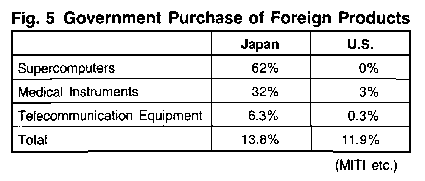
Figure 5 describes the types of computer, medical and telecommunications equipment being discussed at the U.S.-Japan Framework Talks on government procurement of products. The way I see it, the biggest impediment to reaching agreement is the lack of U.S. effort in determining the actual facts. Figures 3 and 4 illustrate how wrong it is to assume, as some do, that a strong yen will alleviate the trade imbalance. Those who make this assumption argue that since the United States and Japan are industrialized societies, Japanese products should become less competitive with the appreciation of the yen. Thus, they believe that Japanese exports will fall and U.S. exports will rise, restoring the trade balance. This is the premise on which their argument rests.
By contrast, I would compare my viewpoint to that of Galileo Galilei, who argued 362 years ago that the Earth revolves around the sun. Only recently did the Pope finally acknowledge Galileo's theory as being correct -- it only took 360 years! Well, I believe that Ptolemaic Theory, which held that the sun revolves around the Earth, is the modern-day equivalent of the argument that "a strong yen will reduce the trade surplus." I take a Galileo-style approach and go against the popular assumptions made about the yen-dollar ratio -- however, I do hope it will not take 360 years to prove my theory correct!
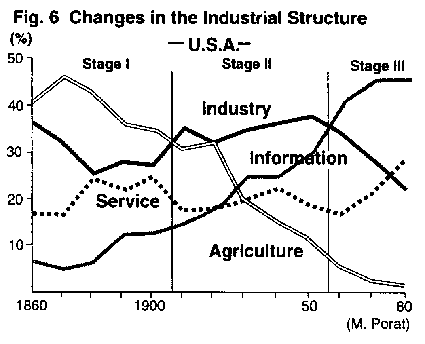
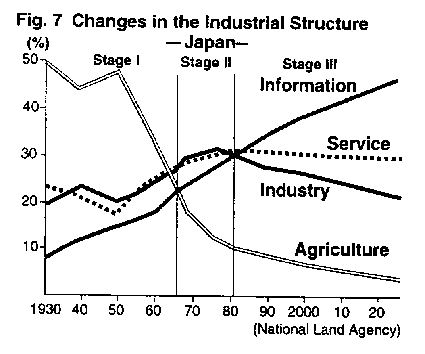
Figures 6 and 7 show the evolution in the industrial structures of the United States and Japan, and explain how the trade imbalance developed. In the United States, manufacturing industries accounted for barely 20 percent of total employment in 1980. U.S. Department of Commerce statistics put the current figures at 16 percent. If the United States can be called an "information" society then Japan would be a "backyard industry" society. This is evident in the current trade imbalance.

Figure 8 shows that Japan exported $16.4 billion worth of "products not made by U.S. companies" in 1992, such as facsimile machines, VCRs and cameras, and $48.7 billion in "capital goods," such as machine tools and IC memory devices. These capital goods are indispensable to American computer manufacturers and even to certain types of automobile manufacturers. Facsimile machines are essential to office efficiency as are VCRs to home entertainment. We must emphasize that the products that Japan exports to the United States are critical to the success of U.S. industry and the corporate community. They contribute as well to the high-quality of life that the United States enjoys -- we must ensure that this point is perfectly understood.
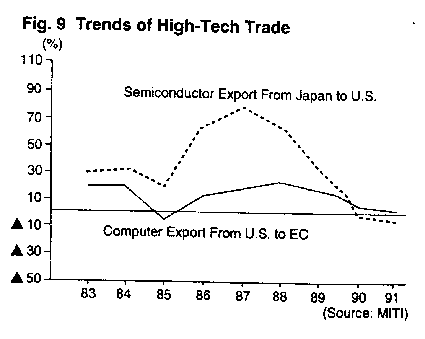
Figure 9 illustrates the strong correlation between rising U.S. computer exports to the European Community and rising semiconductor exports from Japan -- a fact that I pointed out to Ms. Hills during our 1991 meeting.
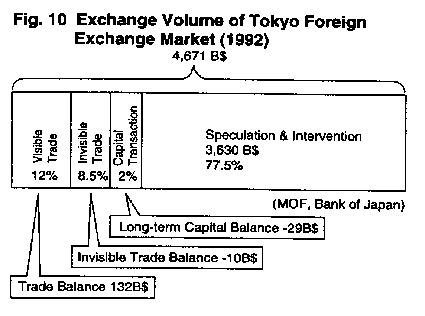
The problem of the relationship between the foreign exchange rate and the trade imbalance is illustrated clearly by Figure 10, which shows the exchange volume in the Tokyo Foreign Exchange Market in 1992. There is no need for further explanation here -- it can be clearly seen that the portion corresponding to real demand in the form of visible trade, invisible trade and capital transactions barely exceeds 1 trillion yen. At the recent Naples Economic Summit, the finance ministers meeting concluded that current exchange rates are not in keeping with economic realities -- why then did they not issue some sort of declaration on redressing the problem? In my opinion, the absence of any attempt to deal with this issue made the whole summit a mere show.
Nevertheless, the surplus refuses to be ignored, so we must examine ways to recycle the trade surplus and make our contribution to the health of the global economy. First, it goes without saying that we must endeavor to boost imports through deregulation and similar efforts. Of course, American firms must also try to provide products that appeal to the Japanese market. Many American products hold great appeal for the Japanese public -- Schick razors, for instance, currently hold a market share of 70 percent, as does Polaroid, while Coca-Cola holds 62 percet.
The other day the chairman of Schick's parent company presented me with a new razor. He came all the way to see me just to express his appreciation of the fact that I keep saying always use Schick razors! Basically, we Japanese like foreign goods -- imported goods. In fact the tie I am wearing actually comes from Paris.
The second thing we must do is boost foreign direct investment, with one proviso -- exchange rate stability must be achieved. Everyone remembers the losses suffered by Japanese investors over the last seven or eight years as a result of the appreciating yen. The ongoing stability of exchange rates is an essential prerequisite for further foreign direct investment by Japanese business.
Next we must look at our ODA contributions. Japan is the current leader in ODA with contributions totaling $11.1 billion annually or 0.30 percent of GNP, followed by the United States at $10.8 billion or 0.18 percent of GNP. Japan's ODA contributions should ideally be boosted to about 0.7 percent of GNP.
Japan must also undertake more technological joint ventures with other nations. Projects such as manned space stations and nuclear fusion experiments should have their own individual funding lines in the budget. These projects could be funded by creation of an "international contribution tax" or something of that form.
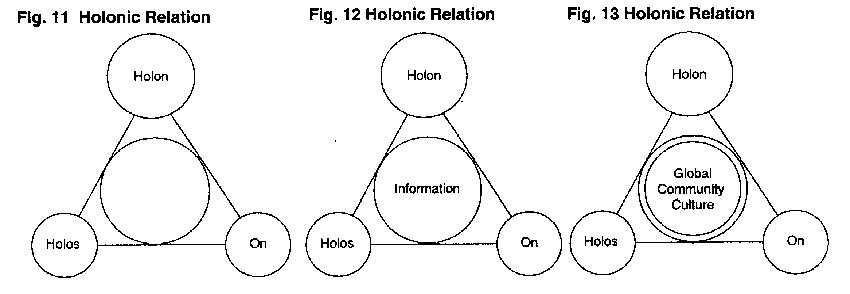
We must also work to standardize systems and procedures. Figure 11 shows the Greek words On, meaning "individual," and Horos, meaning "the whole." I have always emphasized the need in human relations to respect the individual while moving ahead for the good of the whole group. This is equally true of relations between nations -- we as industrialized nations must display the wisdom to work together for the good of "the whole" while respecting each other's cultures and individual societies, rather than trying to foist our ways on each other.
Figure 12 shows one example of this approach to information sharing. We need an ideal to aspire to -- a global community culture as shown in Figure 13, which can be created by pooling our collective knowledge for the benefit of all. This approach requires better communications and, to this end, a study group headed by Keidanren Chairman Toyoda will leave for the United States on Nov. 8 to meet the Business Roundtable and Center for Strategic International Studies (CSIC). The delegation is also meeting influential government representatives to discuss the need for better communication and more comprehensive information sharing.
This brings me to my last point -- due to time constraints, I have decided to outline the key issues on which the media should focus and then I will accept questions. I believe that members of international media should:
The major issue of concern at the moment, with respect to hollowing-out is the future of domestic employment. Japanese companies, such as NEC, began setting up overseas operations more than 20 years ago. We have been producing goods for Japan as well as other markets, striving to develop value-added goods, providing over 25,000 local jobs in nations around the world and expanding employment at home. Our challenge is to continue to expand our global presence while we ensure stable employment at home.
I do believe that the Japanese economy will continue to grow, as long as we continue to carry out R&D at home and retain the capacity to develop new fields of business, although I understand that this is easier said than done under present conditions, The Ministry of Posts and Telecommunications estimates that the multimedia industry will be valued at 123 trillion yen and provide employment for 2.37 million people by the year 2010. Whether these protections are accurate is another matter, but I nevertheless believe that the multimedia industry is an arena in which Japan can excel -- carving out new areas of business and continuing to grow.
Finally, I believe that the East Asian economies are poised to take off and we will also benefit from their new-found economic strength.
The second point I want to make here should answer your question head-on. I understand you to mean that the Japanese software industry is not very profitable and that profit margins have not risen in line with the growth of the industry. It has to be said that Japanese society tends to place a very low value on information and software. However, we are all starting to realize that this will have to be addressed as we head toward the information society of the future. This awareness will probably rise as income is generated around the world by the sale of Japanese software and profit margins should rise as well. So I think Japan will be all right if we strive to address these issues, while continuing to take advantage of the patience of domestic shareholders, which I mentioned at the outset.
Finally, I should say that in the event that American-style, post-capitalist institutional investors come to dominate today's Japan, leading executives of large Japanese firms, especially ones like ours, would probably go homeless.
Thank you for allowing me the opportunity to make a presentation and to be able to share a very enjoyable time with you today -- thank you very much.